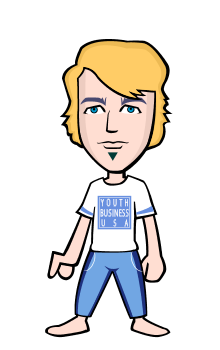The bright green grasslands of Ireland always seem to the visitor to be just a little greener than anywhere else. It may be the soft air, or it may be the moist climate that produces this effect.Whatever it is, Ireland deserves its old name of the 'Emerald Isle'. From the strictly practical point of view, the grassland also provides food for the cattle that keep many Irish farmers in business.
Ireland lies in the North Atlantic Ocean, some 60 miles (46 kilometers) west of Britain. With Britain and some smaller islands, it forms the British Isles.
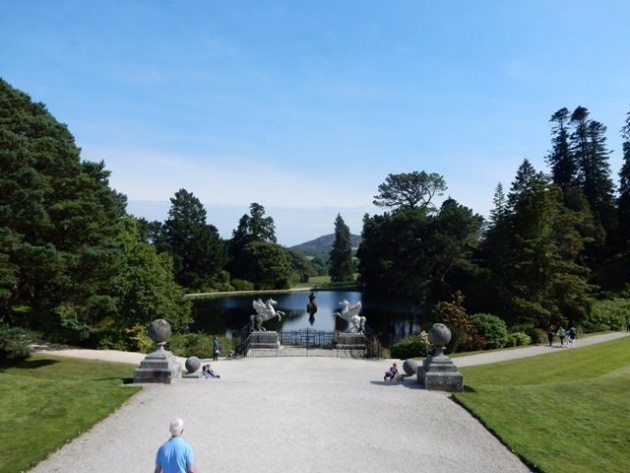
Formal garden and countryside in County Wicklow. Ireland's lush green landscape has made the country known throughout the world as the Emerald Isle.
AN INDEPENDENT COUNTRY
You can see from the map that the Republic of Ireland takes up most of the island. The rest about one sixth-makes up Northern Ireland, which is the part of United Kingdom of Great Britain and Northern Ireland. Northern Ireland sends representatives to the Parliament in London, but the Republic has been independent since 1922. At first, it was called the Irish Free State. After 1937 it was called Eire. And since 1949 its official name has been the Republic of Ireland.
Although it is an independent country, the Republic has many ties with the United Kingdom. Ireland sells more of its products there than anywhere else and buys more from it than it does from any other country.
The Republic has an area of 27,137 square miles (70,285 square kilometers), and a population of 3, 162, 000. It is divided into 17 area boards. Irland is surrounded by the Atlantic Ocean on the north, west, and south. On the east, it is separated from Scotland by the North Channel, from England by the Irish Sea, and from Wales by St George's Channel.
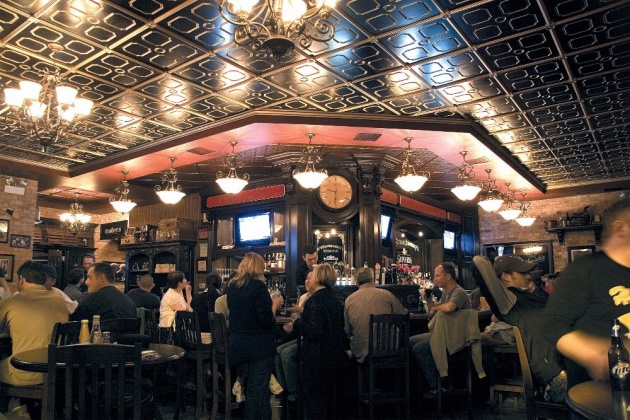
An Irish pub, or public house. Irishmen love to gather and exchange stories over a glass of stout.
THE LIFE OF THE PEOPLE
Most of the people of the Republic of Ireland have Celtic ancestors. (Celts were people who lived in south-western Germany in about 500 B.C.) About 95 people out of every 100 are Roman Catholics. When the English under Henry VIII broke away from the Roman Catholic Church in the 1500s, the Irish remained Catholics. Their ties with the Catholic Church became stronger during the years of English rule because their conquerors were Protestants. This close link with the church has continued and religion plays the part in the life of the people.
The Irish are an easy-going people and great talkers. From earliest times they have taken pleasures in story-telling. Their literature began with the heroic tales told by the bands or poet-singers. It is full of stories about love and war, adventure, and magic. Even after most town-dwellers began to speak English instead of Irish, Ireland continued to produce a great number of important writers.
Among the famous playwrights who grew up in Ireland was Richard Brinsley Sheridan in the 18th century, Oscar Wilde in the 19th century, George Bernard Shaw, John Millington Synge, Sean O'Casey, Samuel Beckett and Brendan Behan in the 20th century. The 20th-century poet William Butler Yeats wrote most of his finest poetry about his native Ireland. The most important novel by the 20th-century writer James Joyce was Ulysses, the story of one day spent in Dublin, the Irish capital. After his publication, he quoted,
"For myself, I always write about Dublin, because if I can get to the heart of Dublin I can get to the heart of all the cities of the world. In the particular is contained universal."
Other Irish people are more likely to show their skill with words over a glass of stout (a dark brown beer), or chatting with a neighbor at the street corner.
Irish, the ancient language of the Celtic people living in Ireland, began to be used less at the beginning of the 19th century. After the country became independent, the government tried to encourage its use once more, but with only a little success. Irish is taught to all school children so that most people know something of it. But is spoken regularly by only a few people living in lonely country areas. Irish people speak English with a lilting, musical accent that is sometimes called brogue.
The Irish are great lovers of sport, especially horse racing. The Irish Derby, held in late June, and the Irish Grand National, held at Easter time, attract spectators from all over the country. The Irish Hospitals Sweepstake is a lottery (a gambling method of raising money) based on Irish and English horse races. The money collected from the sales of tickets is used to build new hospitals in Ireland.
Other popular sports including hurling (a kind of hockey), which is Ireland's national game, and Gaelic football, a variety of soccer. 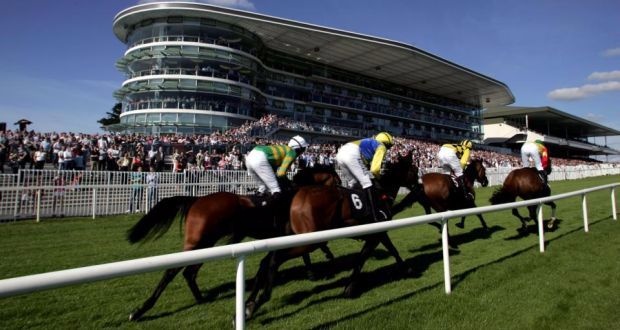
WHAT THE LAND LOOKS LIKE
Ireland is flat in the middle, with mountains forming a ring of high land around nearly all of the coastline. The highest mountain in the country is Carrantuohill, which rises to 3,400 feet (1,040 meters). It is part of the best known of Ireland's mountain ranges, the Margillycuddy's Reeks, in south-western Ireland.
In the east, facing the Irish Sea, there is a stretch of low coast with sandy beaches. Although rivers flow into the sea there, the coast has few really deep inlets. The rugged west coast takes the full force of the Atlantic Ocean. Its sheer cliffs and wild mountain scenery make it a place of great beauty. The most famous of the cliffs are those of Moher in County Clare. They tower more than 600 feet (183 meters above the Atlantic Ocean, and stretch for 5 miles (8 kilometers) along the coast. Deep inlets, such as Killary Harbour and Bantry Bay, bring the sea far into the mountainous land of the west and south.
Fuel from Peat Bogs
The central plain of Ireland is a great limestone plain, some of it covered with peat bogs. The peat is cut and dried and used as fuel. Ireland has no coal, and so peat is used for fuel in both homes and industry. After the peat has been cleared away, the land is prepared for farming. A peat bog in a County Donegal. Peat is cut, dried and used for fuel in homes and industries. The climate is mild, with much rain, especially in the south and southwest. The effect of this weather on the limestone soil has helped to create the rich pastures and lakes for which the country is noted. But the heavy rainfall also makes it difficult to drain the moors and bogs in order to cultivate those regions.
A peat bog in a County Donegal. Peat is cut, dried and used for fuel in homes and industries. The climate is mild, with much rain, especially in the south and southwest. The effect of this weather on the limestone soil has helped to create the rich pastures and lakes for which the country is noted. But the heavy rainfall also makes it difficult to drain the moors and bogs in order to cultivate those regions.
Conserving Peat Bogs
Water for Pleasure and Power
Salmon and trout in the lakes and rivers of Ireland provide plenty of sport for fishermen. The largest loughs (lakes) are Allen, Ree, and Derg. All three are linked by the River Shannon. This is the longest river in the British Isles. From its source in Cunty Cavan in the north, it flows for about 170 miles (273 kilometers) to Limerick. From there, it continues to another 60 miles (96 kilometers) as an estuary (river mouth) in which the sides of the Atlantic rise and fall. Near Limerick, a dam has been built to return the river's power into electricity. Much of Ireland's electricity comes from the power provided by the country's rivers; the burning of peat also helps to produce power.
Other important lakes include Loughs Mask and Corrib, north of Galway Bay, and the lakes of Killarney in County Kerry, often praised for their beauty. The harbor of Cork, Ireland's second city, is formed by the mouth of the River Lee. Three rivers- the Suir, Nore, and Barrow-come together to form Waterford Harbour. A small but important river is the Liffey. It flows through Dublin, the largest city in Ireland.
Ireland, although an island itself, has its own offshore islands. They include Achill Island off County Mayo and the Aran Islands off County Clare.
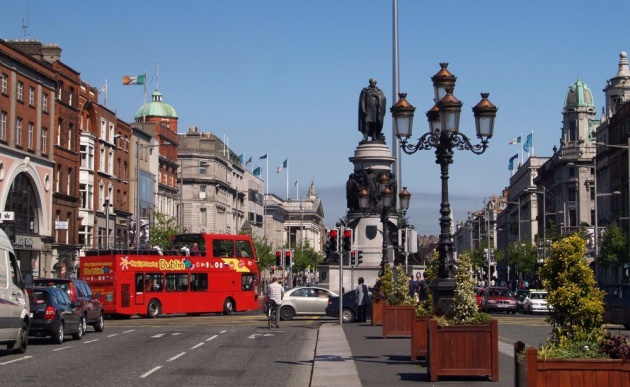 O'Connell Street, Dublin's main street, is named after an Irish patriot. Read here for more information!
O'Connell Street, Dublin's main street, is named after an Irish patriot. Read here for more information!
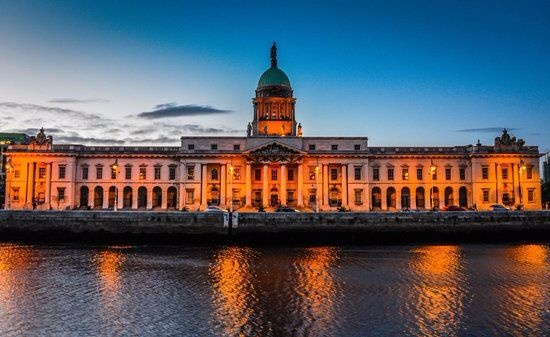 The Dublin Custom House stands on the banks of the River Liffey.
The Dublin Custom House stands on the banks of the River Liffey.
DUBLIN'S FAIR CITY
Dublin, on Ireland's east coast, is the nation's political, industrial, and business center. It has a population of 568,000. But it is not large in comparison to other capital cities. It is possible, therefore, for the people to reach beaches and countryside quite easily. Irishmen claim that O'Connel Street, Dublin;s main street, is the widest street in Europe.
The River Liffey, crossed by several bridges, separates north and south Dublin. On the north bank of the river is the Four Courts (which houses the Irish Law Courts) and the Custom House. These two handsome 18th-century buildings were almost destroyed in the early 20th century by the fighting for Irish independence, but they have been carefully restored.
The world famous Abbey Theatre is also on the north bank of the Liffey. The theater was founded in 1904 as a place where Irish plays could be performed by Irish actors. It was destroyed by fire in 1951 but was rebuilt 15 years later.
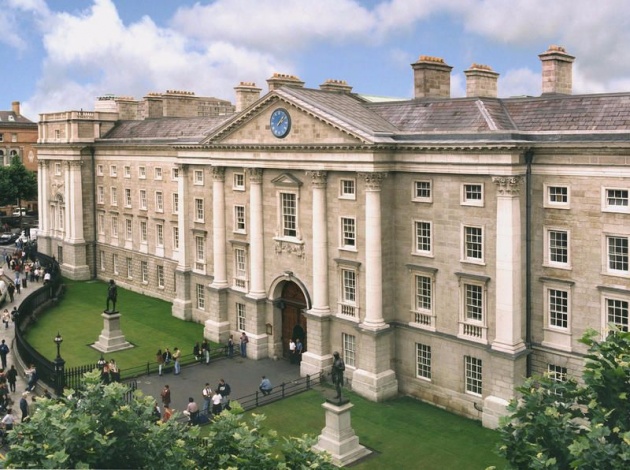
Trinity College, founded in 1591, is Dublin's oldest university. It houses the Celtic manuscript, 'The Book of Kells'.
Things to See in Dublin
South of the river is Dublin Castle, built in about A.D. 1200. On the same side of the Liffey is Christ Church Cathedral, the only Cathedral in the British Isles founded by Danish king (in the 11th century). Nearby is St Patrick's Cathedral, which the Normans built in the 12th century. Jonathan Swift author or the Gulliver's Travels was dean of this cathedral in the 18th century. He is one of the several great writers Dublin has given to the world.
Dublin's oldest university is Trinity College, founded by Protestants in 1592 during the reign of Queen Elizabeth I. The National University, opened in 1904, is made up of three colleges located in Dublin, Cork, and Galway. On exhibit at Trinity College is the Book of Kells, a 9th century Celtic manuscript with beautiful pictures. It shows what wonderful artists Ireland had in those days.
Dublin is noticed for the stouts made in breweries located south of the Liffey. There are numbers of light industries in various parts of the city.
 These stone figures, in an ancient Irish Church, probably date from the 9th century.
These stone figures, in an ancient Irish Church, probably date from the 9th century.
SECOND AND THIRD CITIES
Cork, Ireland's second city, lies about 15 miles (24 kilometers) from the Atlantic Ocean at the mouth of the River Lee.The city's port for ocean goer passenger liner is Cobh on the Great Island at a wide part of the river's mouth. Nearby is a major oil refinery and the main base for the Irish Navy. The city of Cork was built on a cluster of small islands, and water still flows under some of its streets. Many of Ireland farm's products are processed at Cork. It also has chemical factories and many distilleries (places where alcoholic drinks are made).
Ireland's third city, Limerick, lies on either side of the River Shannon. near Limerick is Shannon Free Airport, where many travelers have a chance to break their long air journeys and can buy duty-free goods (articles on which they need not pay taxes). To attract industry and people away from Dublin, the Shannon Free Airport Industrial Estate has been set up there. It houses a number of new factories.
FACTORIES AND FARMS
By the 1970s, the money Ireland made from selling manufactured goods abroad was almost as much as that made from selling its farm products. About a third of the people, however, still earn their living from the land. More and more tourists from crowded industrial cities in other countries began to visit Ireland in search of unspoiled countryside. So tourism became a leading industry.
Ireland's farmers earn most of their money from rearing cattle. The animals provide beef and dairy products such as milk and butter. Sheep and pigs are also reared for sales in the market. Ireland is also noted for its horses that are bred for racing and hunting. Much of the land is given over to pasture for their animals.
The chief crops are wheat, oats, and barley. Root crops such as potatoes and sugarbeet are also grown. Farms in the Western part of Ireland are smaller and generally poorer than those in the rest of the country.
A STORMY PAST
The man has lived in Ireland for thousand of years. Traces of Iron Age settlements have been found there, especially on the coasts. But there is stronger evidence for Bronze Age settlements dating back to 2000 B.C. The Irish Bronze Age people were skilled metal workers. Their gold ornaments were treasured throughout western Europe.
The Coming of Christianity
The Romans, in spite of colonizing Britain, never came to Ireland, Christianity, however, arrived in the first half of the 5th century. St Patrick (389?-461?), and possibly some earlier missionaries, taught the Irish the new religion. Ireland quickly became a center of Christian learning. Monasteries were founded, churches were built and beautiful books and places of worship were made for the use of Christians.
At the Mercy of the Norsemen
Irish art reached its peak between the 6th and 9th centuries when national treasures such as the Book of Kells were made. But this was followed by a period of terror and suffering. Ireland, unlike Roman Britain, did not have to worry about Anglo-Saxon invasions. Instead, it was faced with raids by Norsemen from across the North Sea.
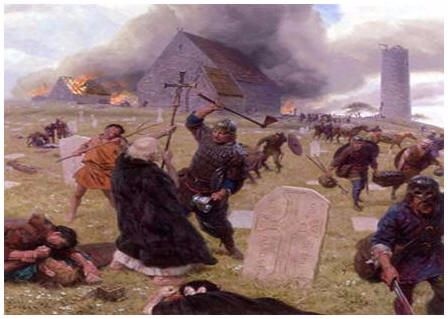 These northern warriors and pirates plundered the monasteries and churches. They built strongholds that later became seaports, at places such as Dublin, Waterford, and Limerick. Ireland was slow to recover. And it was ill-prepared for the shock of the Anglo-Norman invasion in the late 1100s.
These northern warriors and pirates plundered the monasteries and churches. They built strongholds that later became seaports, at places such as Dublin, Waterford, and Limerick. Ireland was slow to recover. And it was ill-prepared for the shock of the Anglo-Norman invasion in the late 1100s.
Normans Come For Keeps
The long-standing troubles between Britain and Ireland all stemmed from the landing of a small force of Welsh, Norman and Flemish knights came to Ireland at the invasion of King Dermot MacMurrough (1110-71). He has been thrown out of the Kingdom of Leinster, and he wanted their help to get back. The knights also came to see what lands they could win for themselves.
The Normans were better armed than the Irish princes, and the castles they built were stronger. They captured the great stronghold of Dublin and drove out the Norse-Irish. From the end of the 12th century.
The Battle of the Faiths
Medieval Ireland was a disturbed land, The Norman and native Irish were fighting each other, while the powerful Anglo-Irish lords were trying to make themselves less dependent on a distant king in London.
During the 16th century, England became a Protestant country. But its rulers were unable to make the Irish give up their loyalty to the Church of Rome. From that time onwards, the two countries quarreled over religion as well as politics.
In many ways, the 17th century was the most tragic in Ireland's history. After a long and bitter war, the Ulster Irish princes were finally beaten. All their lands and the lands of their subjects were taken away from them. The land was given to English and Scottish Protestant settlers. This started the deep division of the population into Catholics and Protestants- a gulf that tore at the heart of Northern Ireland in the 1960s and 1970s.
When Oliver Cromwell (1599-1658) came to power after the English civil was he took all the land from the Irish and gave it to a new class of Protestant (usually English) landowners. The native Irish hoped for some relief when Charles II was restored to the English throne in 1660 because they had been loyal to the King's cause when he had been living out of the country. But Charles did not wish to upset the Puritans. So he allowed their settlers in Ireland to keep most of the land they had been given under Cromwell.
The Beginnings of Independence
From the reign of King George III, (1738-1820) onwards, Britain things began to change in Ireland. The descendants of the British colonists there began to object Britain and limited Ireland's overseas trade; at the way in which the Parliament in Dublin; and at the laws aimed against the Roman Catholic Church.
In 1782 the Irish Parliament did win greater independent, but only for 18 years. Towards the end of the century, a new group called United Irishmen was formed. It worked to win independence and to put an end to anti-Catholic laws. In 1798 it organized an uprising, but this was quickly put down by English soldiers. Because of this rising, the Act of Union was passed. This act called for a sharing of king, parliament, and flag. Not until 1829, however, were offices of any important opened Catholics. This was brought about by Daniel O'Connell. But even he failed to have the Act of Union repealed.
Without Potatoes the People Perish
At the beginnings of the 18th century, the land of Ireland was owned by a few very rich landlords. Many of them did not even live in Ireland. They took no interest in their estates beyond seeing that the tenants paid their rents. And these rents were usually very high. The people were so poor that practically; what they could afford to eat were potatoes.
When diseases destroyed the potato crops of 1845, 1846, and 1847, thousands of men, women, and children starved to death. It was then people began to leave the country to start new lives for themselves and their families in North America and other countries. Between 1841 and 1851, the population shrank from 8,000, 000 to 6,500, 000.
The Fight for Home Rule
In the 1870s and 1880s, there began a long, hard-fought campaign for Irish Home Rule. Public opinion in Britain began to support this. But it was not until the outbreak of World War I in 1914 that the British Parliament finally agreed to it.
The protestants in Ulster (the north-eastern part of Ireland that later became Northern Ireland) were strongly against Home Rule. They feared it would open the way for the complete separation of Ireland from the United Kingdom.
This attitude of the Ulster Unionists, as they were called, and the slowness of the English Parliament to agree on Home Rule, encouraged the growth in Ireland of groups of people who were prepared to fight for complete independence. In the opening years of the 20th century a new movement, Sinn Fein (Ourselves Alone), was founded with that aim in mind.
In Easter Week 1916 an armed rising, organized by the more warlike independence leaders, broke out in Dublin, large British forces were rushed there. The city was shelled and the rebels surrendered after 6 days. Fifteen of them were later executed.
Sinn Fein in Command
The executions united the Irish people in their demands for independence day. By the end of World War I, Sinn Fein was supported by a large majority of the people. It sets up its own parliament known as Dail. The Dail defied the British government, and this led to bitter fighting between the republicans and British soldiers.
In1921 a treaty between Britain and Ireland created the Irish Free State. It allowed the six countries in Ulster, where most of the people were Protestants, to decide whether they wanted to join the new state or remain with Britain. The six countries chose to stay in the United Kingdom.
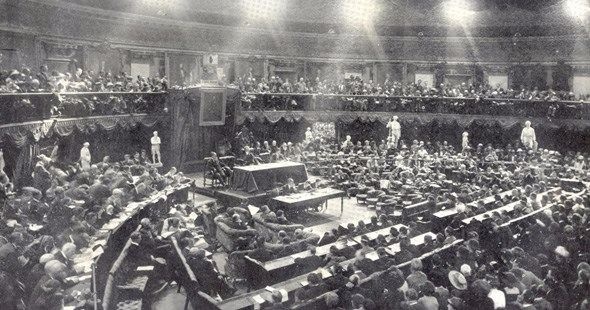 The declaration of independence in the Republic of Ireland in Dublin. This first Dail began in 1919.
The declaration of independence in the Republic of Ireland in Dublin. This first Dail began in 1919.
Civil War and After
Civil war immediately broke out between those who accepted the treaty and those who did not. It was brief but bitter. The Irish fought one another as fiercely as they had fought the British. Most Irish men were sick of war, although the IRA (Irish Republican Army) wanted to continue the fight to unite all Ireland. The civil war ended in May 1923.
Since then, the Republic of Ireland has kept a close watch on the struggles between Catholics and Protestants in Northern Ireland. For many, the dream of a united Ireland remains. At the same times, the Irish government has paid more attention to raising the standard of living of the people who live in the Emerald Isle.
The Irish Civil War Documentary

